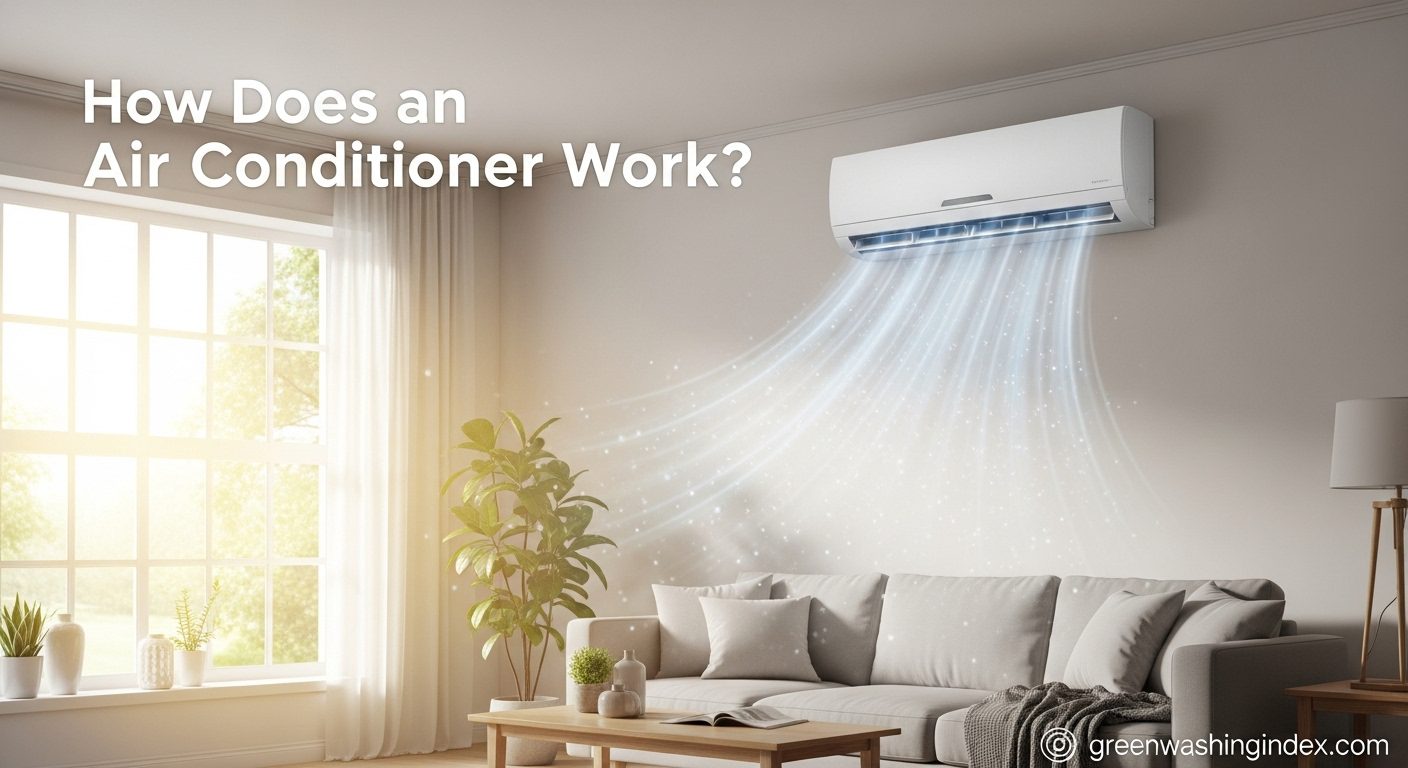

Ever wondered how your air conditioner transforms hot, humid air into cool comfort? An air conditioner is a system that removes heat and humidity from indoor air to create a more comfortable environment through a refrigeration cycle.
AC works by circulating refrigerant that absorbs heat from indoor air and releases it outdoors, using compression and evaporation to transfer thermal energy.
After studying HVAC systems for over a decade and working with countless homeowners, I’ve seen how understanding this process helps people make better decisions about their cooling systems and save money on energy bills.
This guide breaks down everything from basic principles to modern smart technology, helping you understand exactly what happens when you turn on your AC.
Air conditioning isn’t about creating cold air—it’s about moving heat from one place to another. Think of your AC as a heat transporter that continuously moves thermal energy from inside your home to the outside.
Using a special chemical called refrigerant, air conditioners exploit the physical properties of phase changes—when liquid turns to gas and back again. This refrigeration cycle is the same principle that powers your refrigerator, just on a larger scale.
What makes air conditioning truly remarkable is its dual function: while removing heat, it also dehumidifies the air. As warm air passes over cold coils, moisture condenses and drains away, making the air feel even more comfortable.
Refrigeration Cycle: The continuous process of compressing and expanding refrigerant to transfer heat from one location to another, forming the foundation of all air conditioning systems.
The magic happens through thermodynamics—the study of heat and energy transfer. When refrigerant evaporates, it absorbs heat from surrounding air. When it condenses, it releases that heat elsewhere. This simple principle, combined with clever engineering, keeps millions of homes comfortable worldwide.
Every air conditioning system, from a small window unit to a central system, relies on five essential components working together in perfect harmony. Understanding these parts helps you troubleshoot problems and maintain your system effectively.
The compressor is essentially the engine of your air conditioner. This powerful pump pressurizes refrigerant gas, raising its temperature significantly—often to over 150°F. I’ve seen compressors that can pump refrigerant at pressures exceeding 300 PSI, equivalent to the pressure in a scuba tank.
Located in the outdoor unit, the compressor works hardest during the hottest days. It’s the most energy-intensive component, consuming about 30-40% of your AC’s total electricity. Modern compressors use variable-speed technology to adjust output based on cooling demand, improving efficiency by up to 40% compared to older single-stage models.
When your compressor fails, the entire system stops working. That’s why regular maintenance—like cleaning coils and ensuring proper refrigerant levels—is crucial for longevity. A well-maintained compressor can last 15-20 years, while neglected ones may fail in half that time.
After leaving the compressor at high temperature and pressure, hot refrigerant gas flows into the condenser coil. This network of copper or aluminum tubes acts like a radiator, allowing heat to dissipate into the outdoor air.
The condenser uses fans to blow outdoor air across the coils, cooling the refrigerant until it condenses back into a liquid. This phase change releases enormous amounts of heat energy—equivalent to running multiple space heaters simultaneously.
Proper airflow is critical here. I’ve diagnosed many failing systems simply by cleaning debris from condenser coils. Even a thin layer of dirt can reduce efficiency by 20% or more. Professional cleaning annually can restore optimal performance and extend your system’s life.
Before refrigerant can absorb heat again, it must be prepared through rapid depressurization. The expansion valve creates a pressure drop that causes the liquid refrigerant to become extremely cold—often dropping below 40°F.
This component acts like a nozzle, spraying refrigerant into the evaporator coil as a fine mist. The sudden pressure drop causes some refrigerant to instantly vaporize, dramatically lowering the temperature of the remaining liquid.
Modern systems use thermostatic expansion valves (TXVs) that automatically adjust refrigerant flow based on cooling needs. These can improve efficiency by 10-15% compared to fixed orifice systems, especially during partial load conditions.
Located in your indoor unit or air handler, the evaporator coil is where the magic happens. As cold refrigerant flows through these coils, a blower fan pushes warm indoor air across them. Heat transfers from the air to the refrigerant, cooling your home.
The temperature difference between your indoor air (typically 75°F) and the refrigerant (around 40°F) creates substantial heat transfer. This process also causes water vapor in the air to condense on the coils—just like a cold glass on a summer day.
A typical 3-ton AC system can remove up to 36,000 BTUs of heat per hour—that’s equivalent to melting 90 pounds of ice in the same time period. The condensation collected can amount to 5-20 gallons per day depending on humidity levels.
Refrigerant is the lifeblood of your AC system, uniquely designed to change phase at useful temperatures. Modern systems primarily use R-410A, an environmentally friendly alternative to older R-22 refrigerant.
What makes refrigerant special is its low boiling point—around -55°F at atmospheric pressure. This allows it to absorb heat efficiently at indoor temperatures while releasing it at outdoor temperatures.
⏰ Time Saver: Newer refrigerants like R-32 are replacing R-410A in many systems. They have lower global warming potential and can improve system efficiency by 5-10%.
Your system contains a carefully measured amount of refrigerant—typically 3-10 pounds depending on capacity. Too much or too little can severely impact performance and potentially damage the compressor.
Now let’s trace the complete refrigeration cycle as it happens in real time. This continuous process happens thousands of times per hour whenever your AC is running.
This entire cycle typically takes 30-60 seconds to complete, repeating continuously as long as cooling is needed. The system’s thermostat monitors indoor temperature and cycles the compressor on and off to maintain your set point.
Quick Summary: Your AC doesn’t create cold—it moves heat. Refrigerant absorbs indoor heat, carries it outside, and releases it. The process repeats continuously to maintain comfort.
While the refrigeration cycle remains constant, air conditioning systems come in various configurations to suit different needs and spaces. Each type has unique advantages for specific applications.
| System Type | Best For | Installation Cost | Energy Efficiency | Noise Level |
|---|---|---|---|---|
| Central AC | Whole homes with ductwork | $5,000-$10,000 | High (SEER 16-24) | Low (Outdoor unit) |
| Ductless Mini-Split | Homes without ductwork | $3,000-$8,000/zone | Very High (SEER 20-30) | Very Low |
| Window Units | Single rooms, apartments | $150-$800 | Medium (EER 8-12) | Medium-High |
| Portable AC | Temporary cooling, renters | $250-$700 | Low (EER 6-10) | High |
Central AC provides whole-home cooling through a network of ducts. The system includes an outdoor unit (compressor and condenser) and indoor unit (evaporator coil and blower) connected by refrigerant lines.
These systems offer the most comfortable cooling experience, with consistent temperatures throughout your home and superior humidity control. They’re also the quietest option since the noisy compressor is outside.
For those considering installation, our comprehensive window AC buying guide can help you understand cooling capacity requirements.
Mini-splits provide zoned cooling without requiring ductwork. Each indoor unit connects to an outdoor compressor, allowing independent temperature control in different rooms or zones.
These systems excel in energy efficiency since they avoid duct losses (which can waste up to 30% of cooling energy). They’re perfect for home additions, older homes, or situations where installing ducts isn’t practical.
Window units contain all components in a single box installed in a window opening. They’re the most affordable option and can be removed seasonally.
While not as efficient as central systems, modern window units have improved dramatically. Many now include inverter technology, smart controls, and energy-saving modes that reduce operating costs.
For those debating between options, our portable AC vs window AC comparison breaks down the pros and cons of each approach.
Portable units are freestanding appliances with an exhaust hose that must be vented through a window or wall. They offer flexibility for renters or temporary cooling needs.
While convenient, portable units are typically less efficient and noisier than other options. They also create slight negative pressure in rooms, which can draw hot air from other areas into the space you’re trying to cool.
Today’s air conditioners incorporate sophisticated technology that improves efficiency, comfort, and environmental sustainability. These advances have transformed cooling from a luxury into an accessible necessity.
Modern AC systems increasingly include WiFi connectivity and smart features. These smart air conditioners with WiFi offer remote control, scheduling, and learning capabilities.
Smart thermostats can reduce energy consumption by 15-23% according to EPA studies. They learn your schedule, adapt to weather conditions, and provide detailed energy usage data through smartphone apps.
Voice control integration with Alexa, Google Assistant, and Siri makes operation effortless. Some systems even use geofencing to start cooling when you’re heading home and save energy when you’re away.
Modern AC systems achieve remarkable efficiency through variable-speed compressors, improved heat exchangers, and advanced refrigerants. Today’s top models can use 50% less electricity than units from just 15 years ago.
SEER (Seasonal Energy Efficiency Ratio) ratings provide standardized efficiency measurements. The minimum federal requirement is 14 SEER, but premium systems reach 24+ SEER. Upgrading from a 10 SEER unit to a 16 SEER model can save $400-700 annually on electricity bills in hot climates.
✅ Pro Tip: Look for ENERGY STAR certification when selecting an AC unit. These models exceed minimum efficiency standards by 10-20% and often qualify for utility rebates.
The HVAC industry has made significant progress reducing environmental impact. Modern refrigerants like R-410A and R-32 have dramatically lower ozone depletion and global warming potential compared to older alternatives.
Manufacturing improvements have reduced material usage and increased recyclability. Many components now use recycled aluminum and copper, while proper disposal programs prevent harmful materials from entering landfills.
The industry continues developing natural refrigerants like CO2 and hydrocarbons, which offer near-zero global warming potential. These technologies are already common in Europe and gaining acceptance in the US market.
Knowledge is power when it comes to maintaining your air conditioning system. Understanding how your AC works helps you recognize problems early, communicate effectively with technicians, and make informed decisions about repairs and replacements.
Regular maintenance remains the key to longevity and efficiency. Simple tasks like cleaning or replacing filters monthly, keeping outdoor coils clear of debris, and ensuring adequate airflow around both indoor and outdoor units can extend system life by 5-10 years.
For specific applications like cooling server rooms or small spaces, specialized solutions exist. Our guide to server room air conditioners covers these unique requirements.
As technology advances, air conditioning continues becoming more efficient, smarter, and environmentally friendly. Understanding these fundamentals helps you appreciate the engineering that keeps you comfortable and make choices that benefit both your wallet and the planet.
Remember, your air conditioner is a complex system that deserves professional attention when problems arise. While understanding how it works empowers you as a homeowner, always prioritize safety and call qualified technicians for repairs beyond basic maintenance.

Don't let aphids, slugs, and caterpillars ruin another plant. Take back control with simple, natural methods that actually work.